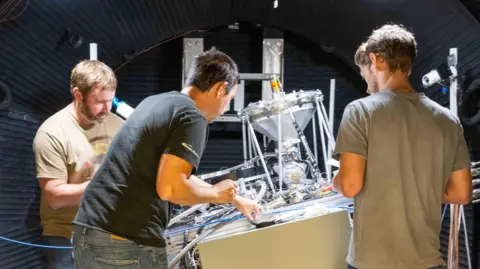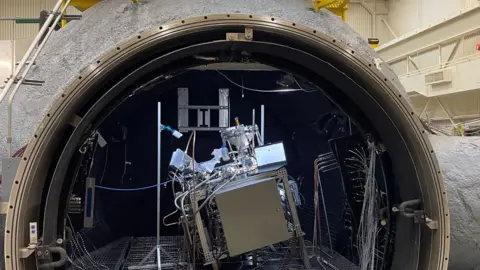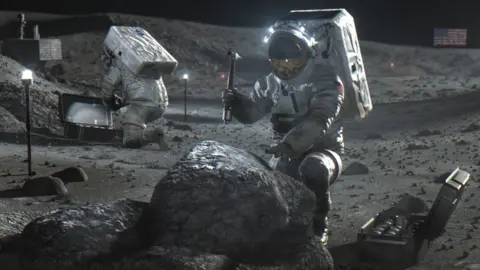Technology reporter
 Sierra
SierraWithin a giant sphere, the engineers threw on their equipment. Before them to stay a silver metallic contraction wrapped in colorful wires – a box they hope to one day make oxygen on the moon.
After the team rested the realm, the experiment began. The box similar to the box was now swallowing small amounts of a dusty regolite-a mixture of dust and sharp gravel with a chemical compound that mimicked the real lunar soil.
Soon, that Regolite was Gloop. A layer of it is heated to temperatures above 1,650C. And, with the addition of some reactants, the oxygen -containing molecules began to bubble.
“We’ve tested everything we can on Earth now,” says Bant White, a Sierra Space program manager, a private company. “The next step is to go to the moon.”
The Sierra Space experiment was unveiled at NASA’s Johnson Space Center this summer. It is far from the only technology for which researchers are working, as they develop systems that can supply astronauts that live on a future lunar base.
Those astronauts will need oxygen to breathe, but also to make rocket fuel for space boats that can start from the moon and head to destinations away – including Mars.
Residents of the lunar base can also require metal and they could even harvest this from the gray dust debris that ignite the lunar surface.
Much depends on whether we can build reactors capable of producing such resources effectively or not.
“This can save billions of dollars from mission costs,” says Mr. White while explaining that the alternative – the behavior of too much oxygen and the reserve metal on the moon from the ground – would be difficult and expensive.
 Sierra
SierraFortunately, the lunar regolite is full of metallic oxides. But while the science of extracting oxygen from metal oxides, for example, is well understood on the ground, doing this on the moon is much more difficult. Not just because of the conditions.
The large spherical room that received Sierra Space tests in July and August this year caused a vacuum and also simulated lunar temperatures and pressures.
The company says it has had to improve how the car works over time, so that it can better handle the extremely clumsy, abrasive structure of the regolite itself. “It gets everywhere, wears all kinds of mechanisms,” says Mr. White.
And it, important, which you cannot try on Earth or even in orbit around our planet, is lunar gravity – which is approximately a sixth of the Earth. It may not be by 2028 or later that the Sierra space can test its system on the moon, using true regolite under low gravity conditions.
 NASA
NASAMoon gravity can be a real problem for some technologies that extract oxygen unless engineers design for it, says Paul Burke at Johns Hopkins University.
In April, he and colleagues published a letter Detailing the results of computer simulations that showed how a different process that oxygen extraction can be hampered by the relatively poor attraction of the moon’s gravity. The process under investigation here was the electrolysis of the melted regolite, which involves the use of electricity to separate lunar minerals containing oxygen in order to extract oxygen directly.
The problem is that such technology works by forming oxygen bubbles on the surface of deep electrodes inside the melted regolite itself. “The consistency, let’s say, heart. Not very viscous, ”says Dr. Burke.
“These bubbles will not grow so quickly – and can actually be delayed by detachment from the electrodes.”
There may be ways about this. One can be to shake the machine that creates oxygen, which can cheat free bubbles.
And extra smooth electrodes can make it easier for oxygen bubbles to disconnect. Dr. Burke and his colleagues are now working for ideas like this.
Sierra Space technology, a carbotermal process, is different. In their case, when bubbles containing oxygen are formed in the Regolin, they do so freely than on the surface of an electrode. It means that there are fewer chances for them to be stuck, says Mr. White.
Emphasizing the value of oxygen for future lunar expeditions, Dr. Burke estimates that, per day, an astronaut would require the amount of oxygen involved in approximately two or three kilograms of Regolite, depending on the levels of fitness and astronaut activity.
However, the life support systems of a lunar base are likely to recycle the oxygen received by astronauts. If so, it would not be necessary to process so much Regolite just to keep lunar residents alive.
The case of real use for oxygen -making technologies, Dr. Burke adds, is in providing oxidizer for rocket fuels, which can enable ambitious space exploration.
 MIT and Shaan Jagani
MIT and Shaan JaganiOf course the more resources that can be made on the moon the better.
The Sierra Space system requires the addition of some carbon, though the firm says it can recycle most of this after each oxygen manufacturing cycle.
Together with colleagues, Palak Patel, a doctoral student at the Massachusetts Institute of Technology, came out with an experimental The electrolysis system of melted regoliteto extract oxygen and metal from lunar soil.
“We are really seeing it from the point of view of,” let’s try to minimize the number of supply missions, “she says.
When designing their system, Mrs. Patel and her colleagues addressed the problem described by Dr. Burke: that low gravity could prevent the oxygen bubbles formed in the electrodes. To oppose this, they used a “voice”, which bursts with sound wavy bubbles in order to move them.
Ms. Patel says future cars that extract resources on the moon could extract iron, titanium or lithium from Regolith, for example. These materials can help astronauts residing lunar to make 3D printed spare parts for their moon base or replacement ingredients for the damaged vessel.
The benefit of the lunar regolite does not stop here. Ms. Patel notes that, in separate experiments, she has melted the simulated regolite into a rough, dark, glass material.
She and colleagues worked on how to turn this substance into strong, empty bricks, which can be useful for building structures on the moon – An imposing black monolithSay. Why not?
